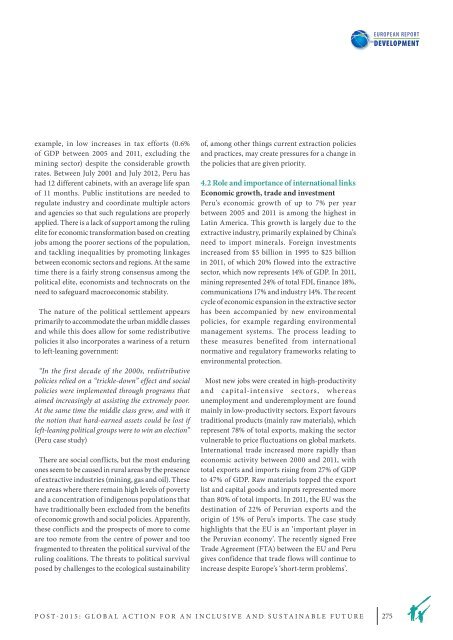Post 2015: Global Action for an Inclusive and Sustainable Future
Post 2015: Global Action for an Inclusive and Sustainable Future
Post 2015: Global Action for an Inclusive and Sustainable Future
Create successful ePaper yourself
Turn your PDF publications into a flip-book with our unique Google optimized e-Paper software.
example, in low increases in tax ef<strong>for</strong>ts (0.6%<br />
of GDp between 2005 <strong>an</strong>d 2011, excluding the<br />
mining sector) despite the considerable growth<br />
rates. between July 2001 <strong>an</strong>d July 2012, peru has<br />
had 12 different cabinets, with <strong>an</strong> average life sp<strong>an</strong><br />
of 11 months. public institutions are needed to<br />
regulate industry <strong>an</strong>d coordinate multiple actors<br />
<strong>an</strong>d agencies so that such regulations are properly<br />
applied. there is a lack of support among the ruling<br />
elite <strong>for</strong> economic tr<strong>an</strong>s<strong>for</strong>mation based on creating<br />
jobs among the poorer sections of the population,<br />
<strong>an</strong>d tackling inequalities by promoting linkages<br />
between economic sectors <strong>an</strong>d regions. at the same<br />
time there is a fairly strong consensus among the<br />
political elite, economists <strong>an</strong>d technocrats on the<br />
need to safeguard macroeconomic stability.<br />
the nature of the political settlement appears<br />
primarily to accommodate the urb<strong>an</strong> middle classes<br />
<strong>an</strong>d while this does allow <strong>for</strong> some redistributive<br />
policies it also incorporates a wariness of a return<br />
to left-le<strong>an</strong>ing government:<br />
“In the first decade of the 2000s, redistributive<br />
policies relied on a “trickle-down” effect <strong>an</strong>d social<br />
policies were implemented through programs that<br />
aimed increasingly at assisting the extremely poor.<br />
At the same time the middle class grew, <strong>an</strong>d with it<br />
the notion that hard-earned assets could be lost if<br />
left-le<strong>an</strong>ing political groups were to win <strong>an</strong> election”<br />
(peru case study)<br />
there are social conflicts, but the most enduring<br />
ones seem to be caused in rural areas by the presence<br />
of extractive industries (mining, gas <strong>an</strong>d oil). these<br />
are areas where there remain high levels of poverty<br />
<strong>an</strong>d a concentration of indigenous populations that<br />
have traditionally been excluded from the benefits<br />
of economic growth <strong>an</strong>d social policies. apparently,<br />
these conflicts <strong>an</strong>d the prospects of more to come<br />
are too remote from the centre of power <strong>an</strong>d too<br />
fragmented to threaten the political survival of the<br />
ruling coalitions. the threats to political survival<br />
posed by challenges to the ecological sustainability<br />
of, among other things current extraction policies<br />
<strong>an</strong>d practices, may create pressures <strong>for</strong> a ch<strong>an</strong>ge in<br />
the policies that are given priority.<br />
4.2 Role <strong>an</strong>d import<strong>an</strong>ce of international links<br />
Economic growth, trade <strong>an</strong>d investment<br />
peru’s economic growth of up to 7% per year<br />
between 2005 <strong>an</strong>d 2011 is among the highest in<br />
latin america. this growth is largely due to the<br />
extractive industry, primarily explained by china’s<br />
need to import minerals. Foreign investments<br />
increased from $5 billion in 1995 to $25 billion<br />
in 2011, of which 20% flowed into the extractive<br />
sector, which now represents 14% of GDp. In 2011,<br />
mining represented 24% of total FDI, fin<strong>an</strong>ce 18%,<br />
communications 17% <strong>an</strong>d industry 14%. the recent<br />
cycle of economic exp<strong>an</strong>sion in the extractive sector<br />
has been accomp<strong>an</strong>ied by new environmental<br />
policies, <strong>for</strong> example regarding environmental<br />
m<strong>an</strong>agement systems. the process leading to<br />
these measures benefited from international<br />
normative <strong>an</strong>d regulatory frameworks relating to<br />
environmental protection.<br />
most new jobs were created in high-productivity<br />
<strong>an</strong>d capital-intensive sectors, whereas<br />
unemployment <strong>an</strong>d underemployment are found<br />
mainly in low-productivity sectors. Export favours<br />
traditional products (mainly raw materials), which<br />
represent 78% of total exports, making the sector<br />
vulnerable to price fluctuations on global markets.<br />
International trade increased more rapidly th<strong>an</strong><br />
economic activity between 2000 <strong>an</strong>d 2011, with<br />
total exports <strong>an</strong>d imports rising from 27% of GDp<br />
to 47% of GDp. raw materials topped the export<br />
list <strong>an</strong>d capital goods <strong>an</strong>d inputs represented more<br />
th<strong>an</strong> 80% of total imports. In 2011, the Eu was the<br />
destination of 22% of peruvi<strong>an</strong> exports <strong>an</strong>d the<br />
origin of 15% of peru’s imports. the case study<br />
highlights that the Eu is <strong>an</strong> ‘import<strong>an</strong>t player in<br />
the peruvi<strong>an</strong> economy’. the recently signed Free<br />
trade agreement (Fta) between the Eu <strong>an</strong>d peru<br />
gives confidence that trade flows will continue to<br />
increase despite Europe’s ‘short-term problems’.<br />
poSt-<strong>2015</strong>: <strong>Global</strong> actIon For <strong>an</strong> IncluSIvE <strong>an</strong>D SuStaInablE FuturE<br />
275

















